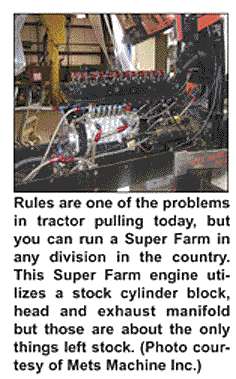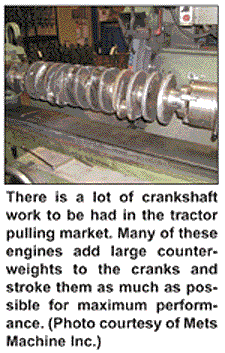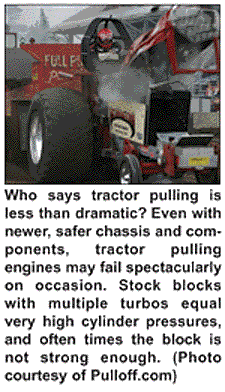If you’re a lover of horsepower, dirt and "black smoke," you may also have a passion for building engines in the thriving diesel tractor pulling market. These engines aren’t just for working in the fields anymore – they’re full blown, smoke billowing, brute force racing machines – and building them can lead to a bountiful harvest for builders who wish to farm this field.

The vehicles that pull weight for a living range from modified farm tractors, modified 2-wheel drive trucks and 4x4s, as well as street-legal pickups for the aspiring puller. Pulling vehicles are hooked to a weight transfer sled that moves the weight from front to back as it’s pulled down a 300 ft. long track. If the sled is pulled the entire distance, pulling aficionados cheer a "full pull."
Although there are both gas and diesel powered pulling classes, we will concentrate on the diesel pulling classes at this time. Our experts say that diesel classes make up the bulk of tractor pulling market, with only a few gas and alcohol powered tractor classes at the national level.
Engine Builder contributor and resident tractor-pulling expert, Jim Walbolt, says the pulling market is pretty large if you take into account all the pulling that goes on around the country. "There are a lot of unsanctioned pulling events that we call ‘brush pulling.’ And there are some major tractor pulling organizations that sanction hundreds of events across the country."
The largest tractor pulling organization in the U.S. is the National Tractor Pullers Association (NTPA), which will sanction about 250 events per year – about 75-100 of those are National events. The rest of the events are member-state sanctioned. The NTPA Grand National Pulling Championship is considered by many as the top rung in tractor pulling and has about 1,400 licensed competitors. It currently has 11 divisions at the Grand National level with most of them setup for diesel-powered tractors. Diesel powered classes include Super Farm, Super Stock, Pro Stock, Super Stock Diesel.

On a regional and national level the tractor pulling classes break down similarly with some slight modifications.
The modern pulling tractor appears to look like a regular farm tractor with the sheet metal resembling a stock tractor, the only real giveaways have been the exhaust stack and huge tires, but in recent years it has gone much further as rules have allowed pullers to make their own chassis as well. Today’s tractors are much like funny cars with stock bodies, they’re completely purpose-built pulling tractors today for more safety and performance according to our experts.
The modified tractor classes are typically turbocharged, stock block diesel engines that can crank out anywhere from 200-3,000 hp, depending on the class and number of turbochargers you’re allowed to run.
There are more Super Farm tractors out running in pulling events than in any other class. Rules are one of the problems in tractor pulling today, but you can run a Super Farm in any division in the country. Everybody has a Super Farm class.
The NTPA was the first of the major pulling organizations, and it was founded in the ’60s by a group of farmers in the Midwest who wanted to start forming uniform rules and safety standards. Today it has digressed a little back to local events forming their own rules, according to some experts.

For instance, at the national level, obviously there are uniform rules, but the same tractor at a national event may not be legal at the state level, which is a big problem today. Another issue, say experts, is the excessive cubic inches in the classes. These classes are utilizing eng-ines that were designed for 466 cid and pushing them to 680 cid, and then they put 100-300 psi of boost on top of that, depending on the class. Therefore, a lot of the blocks don’t stay together.
Diesel tractors at the state level are still the backbone of tractor pulling, according to Dick Morgan of Pulloff.com, a website dedicated to tractor pulling. "Alcohol tractors have made inroads but the only spot you’re seeing alcohol engines is in the light and heavy Super Stock class because you cannot run alcohol in the Super Farm, Pro Stock or, obviously, Diesel Super Stock class. So there is still a very large market of Diesel Super Stock at the state level."
Jerry Logod of Hypermax Engineering, Inc., Gilberts, IL, says it’s difficult to be too precise about how much power the pulling tractors put out because of all the classes and divisions involved and the number of turbos permitted. "Some of the classes, like Pro Stock, are a high end class with a single turbocharger. Those engines make in excess of 2,000 hp. Multi-turbocharger classes can make in excess of 3,000 hp."
The top diesel classes will run between 6,000 and 7,000 rpm, which is much more than a stock diesel tractor that may be only as high as 2,200 rpm.
"Diesels turn maximum rpms at the line when they’re taking off," Logod explains. "It’s a little bit different than drag racing in that sense because the tractor is pulling a sled. It’s the maximum hp at the line because of the high rpm but the diesel engine doesn’t make maximum torque until it has a load placed on it. For max boost pressure the tractor has to be locked into the track otherwise it spins the tires and loses traction."
Logod says, "A diesel engine is a very accurately machined piece. The deck heights, for example, are very accurate so there’s no reason to deck them like you would a gasoline engine, therefore bolt-on parts are not uncommon."
The injectors need to have higher flow and be able to withstand high pressures and higher operating frequency. The pumps are all purpose-built for pulling in the high-end classes.
"The neat thing about the diesels is you can burn up a cylinder or tear up an engine pretty bad, but you can pull the head off and knock the wet-sleeve out and drop in a new one easily," Logod explains. "Barring any catastrophic failures, these engines typically can last for up to one hundred 15 second passes before a full rebuild."
Logod says most of his customers are running the higher-end tractor pulling classes, which means big dollar engines, typically costing in excess of $50,000.
Bryan Menke of R&R Engine and Machine (2006 Machine Shop of the Year) in Akron, OH, says his shop services many of the tractor pulling classes in the area. Menke says the "Unlimited" and "Super Modified" owners are the ones who want to turn their engines as many rpm as possible and modify them as much as they can. "Basically the only thing stock left on these tractors is the engine block."
In most cases, Menke says his tractor pulling customers know what they want done to their engines. "We’ll take an old John Deere and bore it out to put in a large oversized jug and piston in it. These guys know what they want on the cranks too. They generally want them stroked by so much.
"We do some injector pump work for these engines as well," continues Menke. "We laser out injector kits, put bigger plungers in the pumps, cut the flyweights or take some weights out to make them go faster. Once you do that you have to modify the rest of the pump, including the delivery valve, lines and camshaft. Once they get going, customers can easily spend $5,000 on a pump.
Menke says you can’t just jump into building these engines without doing your homework. His customers are very knowledgeable about their engines as well as the rules and what specs to build to. Consequently, in most cases, R&R doesn’t build the engines completely they just perform the machine work. Menke says many of these guys will, in fact, assemble the engines themselves.
Diesel tractors are available from a variety of engine manufacturers, which tractor pullers refer to by color. You’ve undoubtedly heard of John Deere Green and International Red among others. Performance parts are available from many specialty companies like Hypermax, which services all manufacturers but mainly specializes in International engine components.
"We specialize in the old International DT466 based engine," says Logod. "There’s no such thing as an International Farm Tractor anymore – they’ve been out of business for almost 20 years. But people still pull with those old chassis and use the old engines. We manufacture everything for these engines today.
"I was an engineer for International for 15 years. That’s how I got involved with tractor pulling engines. We now manufacture just about everything for these engines including the turbocharger, fuel injection pumps, etc. We sell fuel systems and turbochargers for any style tractor but the engine components we sell are specifically for International engines."
Logod says the cylinder heads he builds have higher flow ports than the original and the wall thickness in critical areas has been increased. "A lot of what we do is common in gasoline performance engines, only in diesel scale."
"We cast the port as we want it to be for that application," Logod explains. "The block that we manufacture for International tractors is beefed up quite a bit from stock. Up until a year ago we utilized the standard production engine block that was designed back in 1970. It was quite a good design and they stopped building this design about 10 years ago. It was referred to as 66 series engine. There is the 436 and 466 conversion that was put in farm tractors and other Ag equipment. There’s a good selection of parts still available for these engines, and there’s still a lot of engines in junkyards, so if a guy is a budget puller he can go to a tractor or truck junkyard and pick up a block and crank and rods, and so on."
Butch Gilger, Mets Machine Shop Inc. in Mansfield, OH, says he builds a lot of what is affectionately called "black smoke" diesels for the Ohio State Tractor Puller Association (OSTPA), and he currently sponsors the Super Farm class in that division. In the Super Farm class pullers have to use a stock block, head, intake and exhaust. There are also some limitations on the injector pump and turbo, but they’re not stock. The rules are in place mainly to try and contain costs for the competitors.
How much does a Super Farm engine cost? "How much do you have?" asks Gilger, only semi-facetiously. "The SuperFarm engines can fetch as much as $20,000. We also built a ProStock engine this year that we charged $110,000 for."
Tractor pulling is mainly a hobby, and some would even say it’s an addiction, but, as revealed, there are people spending serious money to do it. Most of the competitors work on farms or farm related industry, according to pulling experts. Some of the competitors have their own businesses also.
What some people find amazing about tractor pulling is that while there is a lot of money spent on engines, parts and equipment, our experts say that pullers generally don’t make any money from the events. "If anyone tells you that these guys pull for money, they’re nuts!" says Logod. "There’s not really any prize money in pulling. But that still doesn’t stop people from competing. There are still a healthy number of competitors at both national and local level pulling. And the sport hasn’t really been affected much by the high fuel prices from what I’ve seen."
Logod recalls that 25 years ago or so, there was a concern for tractor pulling’s survival.
"In the early ’80s the farm economy in this country was really poor, and that definitely affected the tractor pulling as a sport overall. Since then there has been a big turnaround in the sport. The vast majority of tractor pullers are farmers."
Gilger says most pullers don’t have bad habits because they spend everything they have on the sport. "This isn’t a money sport as far as winning money, goes," says Gilger, "but it’s a money sport as far as spending it is concerned."
Gilger says that Mets does a bit of everything, and building pulling engines has been a good niche for them. And now they are starting to build more pulling trucks as well, which has become more popular recently.
"Some of the keys we’ve found to building a good pulling engine is lots of cubic inches and to stroke them as much as possible, Gilger explains. "We always stroke these engines for the necessary torque these applications require.
"We also build some counter-weighted cranks. Our theory here is to create inertia. Once you get the inertia built up it’s hard to slow it down. At the big end of the track you need to keep it going because the weight is getting heavier. We try to keep our rotating mass heavy to give us more inertia and to keep the wheels moving under the load. With a 640 cid limit in most classes, we’re cubic inch limited."
Gilger says building pulling engines is a niche market for his shop, but it’s an area where a competent machine shop could do some of the work or all of the work depending on how much they want to be involved.
"We build tractor-pulling engines for people all over the country, not just in our area. Our Web site helps us get some of our pulling business, but going to the events and getting to know the competitors is what really helps us get this business."
Pullers are often more resourceful than many other racers simply because most are farmers who have become used to making things work using what they have instead of just buying something new. However, that doesn’t mean they don’t spend money. Judging by the cost of their engines it’s obvious that they do, in bushels – without much hope of harvesting a fortune.













